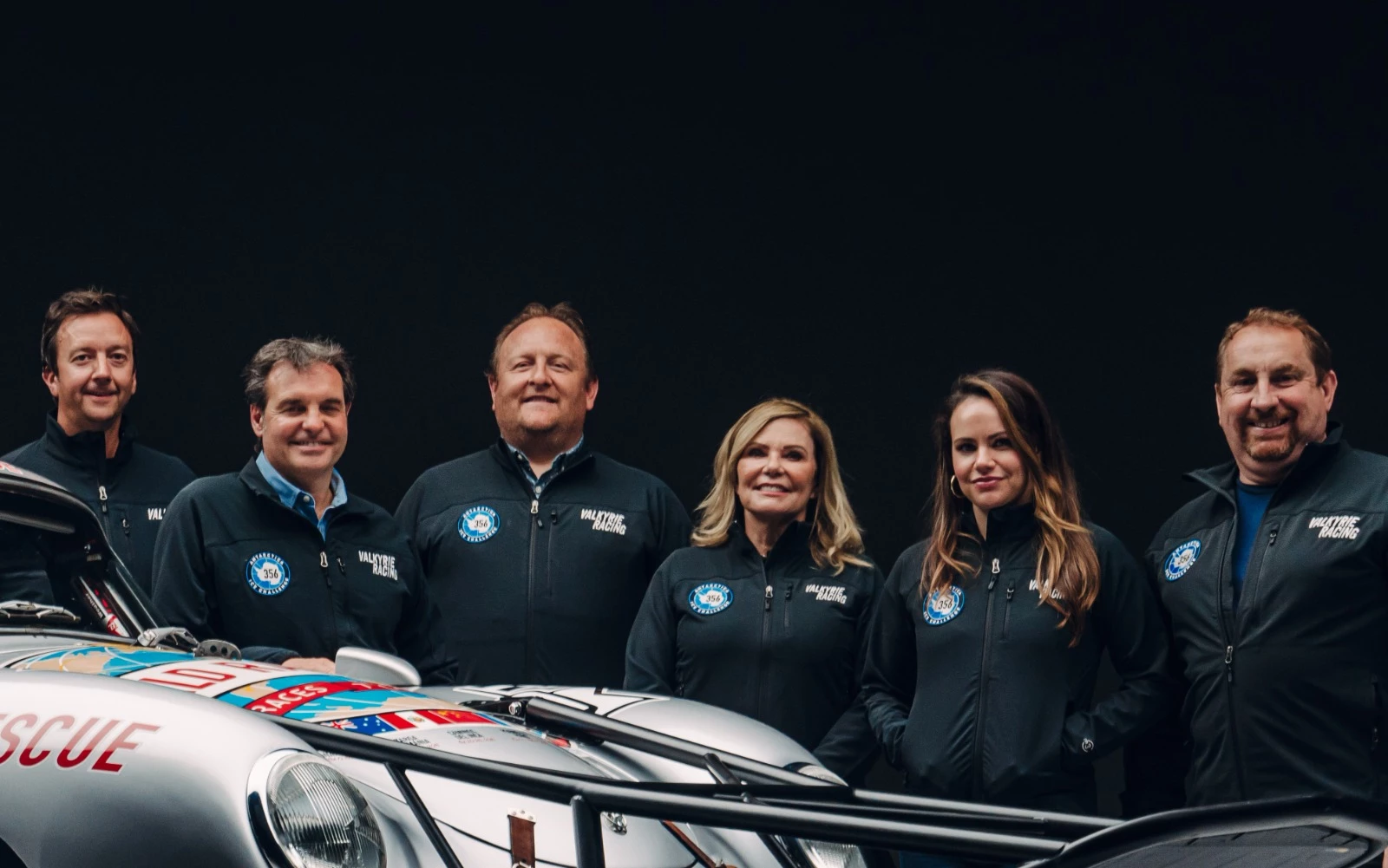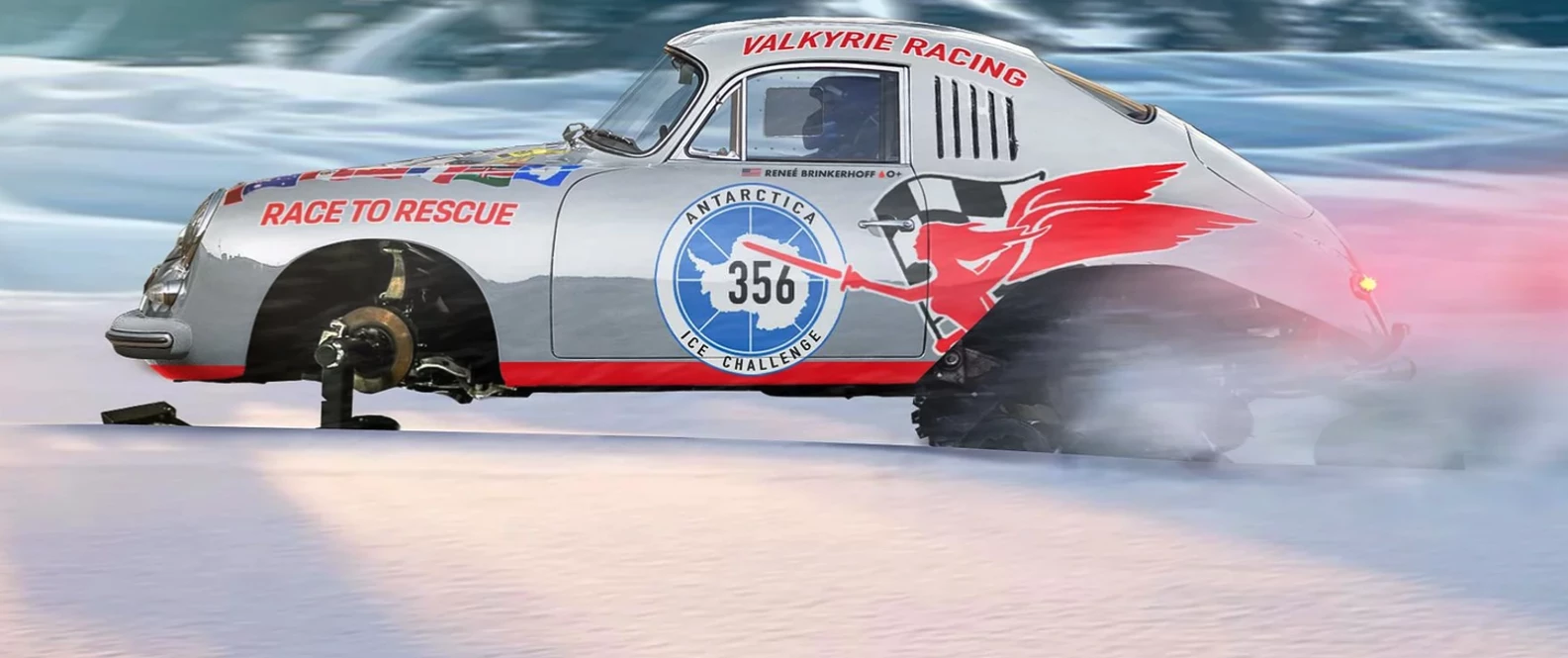If you were planning to travel hundreds of miles across Antarctic snow and ice, you'd probably be looking to captain something like an e-treaded polar snow ferry or concept-grade propeller cruiser, maybe even a specially prepared tricycle. What you wouldn't plan on driving is a vintage sports coupe. But you're not Renee Brinkerhoff, the Valkyrie Racing founder looking to cap off a nearly 20,000-mile seven-continent global journey by power-sledding her way across Antarctica in a 1956 Porsche 356A that rides on skis and treads instead of wheels. Oh, and she'll also attempt an Antarctic land speed record down an icy straightaway for good measure.
After making history in the 2013 Le Carrera Panamericana rally as the first female driver to win her class, Brinkerhoff, then 57, was hooked on both rallying and breaking boundaries. She founded Valkyrie Racing and a few Panamericana podiums later had a bigger vision for rallying the world and supporting a near-and-dear cause while doing it.
In 2017, Brinkerhoff set out to complete what she called the "Project 356 World Rally," motoring across all seven continents in a single vintage Porsche that many owners wouldn't push beyond a cars-and-coffee cruise. The idea has been to race famous endurance rallies the world over, from the Peking-to-Paris, to the East African Safari Classic, to the Caminos Del Inca, while raising money and awareness to battle human trafficking.

As Brinkerhoff traveled the world driving the 356 into clouds swallowing 16,000-foot peaks, across cliff-clinging roadways and over hot Gobi sand, she'd stop along the way to meet with frontline anti-trafficking organizations in distant corners of affected nations, speak with vulnerable populations at villages and orphanages, deliver essential supplies and funding, and help to promote global awareness. Since the start of the project, she has also raised $500,000 toward a $1 million goal. One woman, one vintage car and one global mission.
"The real goal is to use our racing to amplify our voice for human trafficking and find a means to help as many victims as we can through rescue efforts and separately, providing support through education and funding to aid global shelters," Brinkerhoff summed up earlier this year.
No matter how much you love yourself a classic Porsche, you wouldn't want to race tens of thousands of miles of road and natural terrain in a stock 356A. So Valkyrie employed the uniquely qualified minds at British shop Tuthill Porsche to modify the 356A, first for tarmac racing and later for off-roading. Four years, six continents and nearly 20,000 miles later, those modifications appear to have done the trick.
It's not surprising to see Antartica as the very last leg of Valkyrie's seven-continent expedition, and this particular challenge requires a special set of modifications above and beyond Tuthill's expertise. So Valkyrie brought in Lotus senior chassis design engineer Kieron Bradley, himself a multi-world record-holding polar explorer, to make the 356 less of a car, more of a Porsche 356-shaped snowmobile.
In 2011, Bradley and Jason de Carteret set the Guinness World Record for fastest overland journey to the South Pole driving a specially prepared Toyota Tacoma-based Thomson Reuters Polar Vehicle. Bradley and de Carteret also worked together on the design of the 2008 Lotus Concept Ice Vehicle linked in the opening paragraph. De Carteret joins the Valkyrie Antarctic team as Brinkerhoff's navigator.

In the workshop, Bradley's first major decision was to drop the idea of using tires – even the biggest, floatiest out there – and instead proceed with a combination of a rear track drive and front trail-breaking skis, a layout that works quite well in snowmobiles. The 356's front skis are designed to glide through the soft, natural snow, leveling it out into a more solid surface upon which the two rear tracks can push the car forward. According to Valkyrie, the combination boosts flotation by up to 300 percent as compared to Antarctic 4x4 support vehicles rolling 42-inch tires.
Each braced beam securing a ski to the 356's hub points includes its own suspension to prevent stress on the standard vehicle hub and suspension components. Likewise, the rear tracks include a dedicated suspension system. And while the new front and rear feet drastically change the look and purpose of the 356, they're meant to be swapped out with studded ice tires without any wheel realignment.

Beyond the new contact patches, the Antarctic 356 gets a TIG-welded roll cage, a crevasse bar holding a dual-sided solar panel for pulling light both from the sun and reflections off the snow, a 12-V low-temperature compressor and a rear engine-frame winch point. The design packs a survival kit, water and comms equipment within arm's reach and also carries a 4-ton bag jack for use in soft snow. An emergency rear window exit provides an extra way out should things go sideways.
To help compensate for the added weight, Bradley and the Valkyrie crew removed lights and fire extinguishers deemed unnecessary for the polar-weather mission that should coincide with 24-hour sunlit days.
The Antarctic leg of the world rally was originally scheduled to take place in December 2020 but, like so many things, was pushed back to 2021, a move likely applauded by the engineering team as they pushed to perfect their vintage sports car snow machine. The car is on its way to Puntas Arenas, Chile as we type. In December, Brinkerhoff and de Carteret will look to travel 356 symbolic miles (573 km) starting from the Union Glacier before attempting an Antarctic land speed record on a blue-ice runway.
Source: Valkyrie Racing











